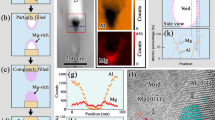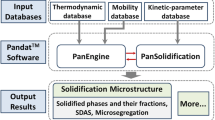Abstract
The role of the microstructure on void growth and linkage in magnesium has been investigated. 2D model materials have been fabricated using pico-second laser technology whereby holes were drilled into the gage section of tensile samples composed of thin Mg sheet. These were pulled in uniaxial tension inside the chamber of an SEM which allowed for a quantitative assessment of the void growth and linkage processes. In contrast to the recent studies of void growth and linkage in fcc metals (copper and aluminum), the local microstructure plays a significant role on the deformation and fracture behavior of magnesium. Void growth was observed to occur non-uniformly due to interactions between the holes and microstructural features such as grain and twin boundaries. In addition, the main fracture mechanisms responsible for void linkage include failure associated with these boundaries. Twin and grain boundaries introduce microstructural features on a length scale comparable to the holes which are not present in models based on continuum mechanics. In order to model the deformation and fracture of magnesium, the initial microstructure as well as microstructural evolution must be taken into account.
















Similar content being viewed by others
References
Abràmoff MD, Magalhães PJ, Ram SJ (2004) Image processing with image. J Biophotonics Int 11(7):36–43
Babout L, Brechet Y, Maire E, Fougeres R (2004) On the competition between particle fracture and particle decohesion in metal matrix composites. Acta Mater 52(15):4517–4525
Barnett MR (2007) Twinning and the ductility of magnesium alloys. Part II. “Contraction” twins. Mater Sci Eng A 464(1–2):8–16
Benzerga A, Besson J, Pineau A (1999) Coalescence-controlled anisotropic ductile fracture. J Eng Mater Technol 121:221–229
Benzerga A, Leblond J-B (2010) Ductile fracture by void growth to coalescence. Adv Appl Mech 44:169–305
Benzerga AA, Leblond J-B (2014) Effective yield criterion accounting for microvoid coalescence. J Appl Mech 81(3):031009
Brown LM, Embury JD (1973) Initiation and growth of voids at second phase particles. Institute of Metals (London), Monograph and Report Series 1(3):164–169
Cox TB, Low JR Jr (1974) An investigation of the plastic fracture of AISI 4340 and 18 nickel-200 grade maraging steels. Metall Trans A 5(6):1457–1470
Gammage J, Wilkinson D, Brechet Y, Embury D (2004) A model for damage coalescence in heterogeneous multi-phase materials. Acta Mater 52(18):5255–5263
Gologanu M, Leblond J-B, Perrin G, Devaux J (2001) Theoretical models for void coalescence in porous ductile solids. I. Coalescence, “in layers”. Int J Solids Struct 38(32):5581–5594
Goods SH, Brown LM (1979) Overview No. 1: the nucleation of cavities by plastic deformation. Acta Metall 27(1):1–15
Greenwood JN, Miller DR, Suiter JW (1954) Intergranular cavitation in stressed metals. Acta Metall 2(2):250–258
Hartt W, Reed-Hill R (1967) The irrational habit of second-order/1011/-/1012/twins in magnesium
Hosokawa A (2011) Void growth and coalescence studied by X-ray computed tomography. (NR73993 Ph.D.), McMaster University (Canada)
Hosokawa A, Wilkinson DS, Kang J, Maire E (2012) Effect of triaxiality on void growth and coalescence in model materials investigated by X-ray tomography. Acta Mater 60(6–7):2829–2839
Hosokawa A, Wilkinson DS, Kang J, Maire E (2013) Onset of void coalescence in uniaxial tension studied by continuous X-ray tomography. Acta Mater 61(4):1021–1036
Kanetake N, Nomura M, Choh T (1995) Continuous observation of microstructural degradation during tensile loading of particle reinforced aluminium matrix composites. Mater Sci Technol 11(12):1246–1246
Kelley E, HOSFORD W (1968) Plane-strain compression of magnesium and magnesium alloy crystals. Trans Met Soc AIME 242(1):5–13
Keralavarma SM, Hoelscher S, Benzerga AA (2011) Void growth and coalescence in anisotropic plastic solids. Int J Solids Struct 48(11–12):1696–1710
Le Roy G, Embury JD, Edwards G, Ashby MF (1981) A model of ductile fracture based on the nucleation and growth of voids. Acta Metall 29(8):1509–1522
Magnusen PE, Dubensky EM, Koss DA (1988) Effect of void arrays on void linking during ductile fracture. Acta Metall 36(6):1503–1509
McClintock FA (1968) A criterion for ductile fracture by the growth of holes. J Appl Mech 35(2):363–371
Nemcko MJ (2015) 2D and 3D analysis on the deformation and fracture of commercially pure magnesium. (Ph.D), McMaster University
Pardoen T, Hutchinson JW (2000) An extended model for void growth and coalescence. J Mech Phys Solids 48(12):2467–2512
Partridge P (1967) The crystallography and deformation modes of hexagonal close-packed metals. Metall Rev 12(1):169–194
Puttick K (1959) Ductile fracture in metals. Philos Mag 4(44):964–969
Rice JR, Tracey DM (1969) On the ductile enlargement of voids in triaxial stress fields*. J Mech Phys Solids 17(3):201–217
Scheyvaerts F, Pardoen T, Onck P (2009) A new model for void coalescence by internal necking. Int J Damage Mech 19:95–126
Simulia DS (2012) Abaqus 6.12 documentation. Providence, Rhode Island, US
Tekog̃lu C, Leblond JB, Pardoen T (2012) A criterion for the onset of void coalescence under combined tension and shear. J Mech Phys Solids 60(7):1363–1381
Thomason PF (1981) Ductile fracture and the stability of incompressible plasticity in the presence of microvoids. Acta Metall 29(5):763–777
Weck A, Crawford THR, Borowiec A, Wilkinson DS, Preston JS (2007) Femtosecond laser-based fabrication of a new model material to study fracture. Appl Phys A A86(1):55–61
Weck A, Segurado J, Llorca J, Wilkinson D, Bohm H (2007) Numerical simulations of void linkage in model materials using a nonlocal ductile damage approximation. Int J Fract 148(3):205–219
Weck A, Wilkinson DS (2008) Experimental investigation of void coalescence in metallic sheets containing laser drilled holes. Acta Mater 56(8):1774–1784
Acknowledgments
The work was supported by NSERC through the Magnesium Network (MagNET). Gratitude is expressed to Hanqing Che and Dr. Warren Poole for rolling of the magnesium sheets at the University of British Columbia. In addition, Eugene Hsu and Dr. Harold Haugen are gratefully acknowledged for use of the laser facility at McMaster University.
Author information
Authors and Affiliations
Corresponding author
Rights and permissions
About this article
Cite this article
Nemcko, M.J., Wilkinson, D.S. Impact of microstructure on void growth and linkage in pure magnesium. Int J Fract 200, 31–47 (2016). https://doi.org/10.1007/s10704-016-0111-0
Received:
Accepted:
Published:
Issue Date:
DOI: https://doi.org/10.1007/s10704-016-0111-0




